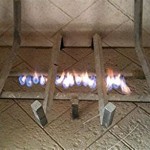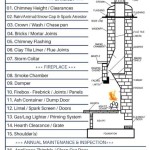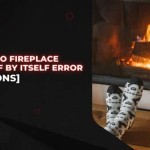Here is an informative article about fireplace gas valve repair, designed to meet the specified requirements:
Fireplace Gas Valve Repair: Understanding, Troubleshooting, and Solutions
The gas valve is a critical component of any gas fireplace, acting as the gatekeeper for the fuel supply. It controls the flow of natural gas or propane to the burner, enabling the fireplace to ignite and produce heat. When a gas valve malfunctions, the fireplace may fail to light, operate erratically, or even present a safety hazard. Therefore, understanding the function, potential problems, and repair options for a gas fireplace valve is essential for homeowners and HVAC professionals alike.
The gas valve is typically a complex electro-mechanical device. It incorporates several components, including a solenoid, a regulator, and a manual control. The solenoid is an electromagnet that opens or closes the valve in response to an electrical signal from the fireplace control system. The regulator maintains a consistent gas pressure to the burner, ensuring a stable flame. The manual control allows for manual operation of the valve in case of a power outage or system failure.
This article will provide a comprehensive overview of fireplace gas valve repair, covering common issues, troubleshooting techniques, and practical repair solutions. It will also emphasize safety precautions that should always be taken when working with gas appliances.
Identifying Common Gas Valve Problems
Several symptoms can indicate a malfunctioning fireplace gas valve. Recognizing these signs early can help prevent further damage and ensure timely repairs. Some of the most common gas valve problems include:
Failure to Ignite: If the fireplace fails to light despite the pilot light being lit (or attempting to light) and the control system functioning correctly, a faulty gas valve is a likely culprit. The valve may be unable to open and allow gas to flow to the burner.
Intermittent Operation: The fireplace may light and operate for a period but then shut off unexpectedly. This could be due to a gas valve that is intermittently failing, possibly due to a faulty solenoid or internal component.
Pilot Light Issues: A weak or unstable pilot light can sometimes be attributed to a gas valve malfunction, particularly if the valve is not providing sufficient gas pressure to the pilot assembly.
Gas Odor: A persistent gas odor, even when the fireplace is not in use, could indicate a leak within the gas valve itself or a failure to completely shut off the gas supply. This situation demands immediate attention and should be addressed by a qualified professional.
Unusual Noises: Strange clicking, buzzing, or hissing sounds emanating from the gas valve could indicate a problem with the solenoid or internal components. These noises should be investigated promptly.
Control System Errors: In some cases, the fireplace control system may display error codes that specifically point to a gas valve malfunction. These codes can provide valuable diagnostic information.
It is important to note that these symptoms can also be caused by other issues within the fireplace system, such as a thermocouple failure, a blocked burner, or a faulty control module. Therefore, thorough troubleshooting is necessary to accurately diagnose the problem.
Troubleshooting a Fireplace Gas Valve
Before attempting any repairs, it is crucial to follow proper safety precautions. Turn off the gas supply to the fireplace at the shut-off valve (usually located near the fireplace or on the gas supply line). Disconnect the power to the fireplace to prevent accidental electrical shocks. Ensure adequate ventilation in the area.
The following steps outline a general troubleshooting process for a fireplace gas valve:
Visual Inspection: Begin by visually inspecting the gas valve for any signs of damage, such as cracks, corrosion, or loose connections. Check the wiring to the valve for any frayed or damaged wires.
Voltage Testing: Use a multimeter to test the voltage to the gas valve solenoid when the fireplace is activated. The voltage should be within the manufacturer's specified range (typically 24 volts AC). If there is no voltage, the problem lies with the control system or wiring.
Solenoid Testing: Disconnect the wires from the solenoid and use an ohmmeter to measure the resistance of the solenoid coil. A significantly high or low resistance reading indicates a faulty solenoid.
Pressure Testing: A manometer can be used to measure the gas pressure entering and exiting the gas valve. This can help determine if the valve is regulating the pressure correctly. If the pressure is outside the acceptable range, the valve may need to be adjusted or replaced.
Pilot Light Inspection: Carefully examine the pilot light assembly, including the pilot tubing and orifice. Clean any debris or obstructions that may be affecting the pilot flame. A weak or unstable pilot flame can sometimes prevent the main burner from igniting.
Thermocouple/Thermopile Testing: The thermocouple or thermopile generates a small electrical current that keeps the gas valve open once the pilot light is lit. Test the output voltage of the thermocouple/thermopile to ensure it is within the manufacturer's specifications. A faulty thermocouple/thermopile can cause the pilot light to go out and the gas valve to close.
Control System Diagnostics: Consult the fireplace owner's manual to understand the control system's diagnostic capabilities. Many modern fireplaces have self-diagnostic features that can provide error codes related to the gas valve or other components. Understanding these codes can greatly simplify the troubleshooting process.
It's crucial to document your findings throughout the troubleshooting process. Record voltage readings, pressure measurements, and any observations that may be relevant to the diagnosis. This documentation can be invaluable when seeking assistance from a qualified HVAC professional.
Repairing or Replacing a Fireplace Gas Valve
The complexity of a gas valve repair often dictates whether it is a task for a homeowner or a qualified HVAC technician. Some minor repairs, such as cleaning the pilot assembly or tightening loose connections, may be within the capabilities of a handy homeowner. However, internal repairs or adjustments to the gas valve should always be performed by a trained professional.
Here are some scenarios and associated repair options:
Solenoid Replacement: If the solenoid is found to be faulty, it can often be replaced independently of the entire gas valve. Ensure that the replacement solenoid is compatible with the specific gas valve model. Disconnect the power and gas supply before replacing the solenoid.
Pilot Assembly Cleaning: A clogged pilot assembly can be cleaned using a small brush or a specialized pilot cleaning tool. Be careful not to damage the pilot orifice. After cleaning, ensure that the pilot flame is stable and properly positioned.
Gas Valve Adjustment: Some gas valves have adjustable regulators that can be used to fine-tune the gas pressure. However, these adjustments should only be made by a qualified technician with the proper tools and knowledge. Incorrect adjustments can lead to dangerous situations.
Gas Valve Replacement: In many cases, the most practical solution is to replace the entire gas valve. This is particularly true if the valve is old, corroded, or has suffered significant internal damage. When replacing the gas valve, it is essential to select a replacement valve that is compatible with the fireplace model and the type of gas being used (natural gas or propane).
When replacing a gas valve, follow these steps:
- Turn off the gas supply and disconnect the power to the fireplace.
- Disconnect the gas lines from the old gas valve. Use pipe dope or Teflon tape on the threads of the new gas valve to ensure a gas-tight seal.
- Disconnect the wiring from the old gas valve.
- Remove the old gas valve from the fireplace.
- Install the new gas valve in the fireplace.
- Reconnect the gas lines and wiring to the new gas valve.
- Turn on the gas supply and check for leaks using a soap and water solution. Apply the solution to all gas connections and look for bubbles.
- Turn on the power to the fireplace and test the operation of the new gas valve.
Following a gas valve replacement, it is important to verify that the fireplace is operating safely and efficiently. Check the flame appearance, gas pressure, and overall performance. If any issues are observed, consult a qualified HVAC technician for further assistance.
Working with gas appliances involves inherent risks. It is essential to prioritize safety at all times. If you are not comfortable performing any of the troubleshooting or repair steps described above, it is best to call a qualified HVAC technician or a licensed gas fitter. They have the expertise, tools, and training to safely and effectively diagnose and repair fireplace gas valve problems.
Regular maintenance, including cleaning the pilot assembly and visually inspecting the gas valve, can help prevent problems and extend the life of the fireplace. Refer to the owner's manual for specific maintenance recommendations.

Replacing A Gas Ball Valve To Your Fireplace

Replacing A Gas Ball Valve To Your Fireplace

Gas Valve Check Does My Quarter Turn Ball Need Replaced

Gas Valve Check Does My Quarter Turn Ball Need Replaced

58 Log Lighter Gas Valve Complete Kit

Fireplace Gas Valve Leaking Found By Dallas Home Inspector Greg House

How To Test Your Main Control Valve Www Mygasfireplacerepair Com

Fireplace Gas Valve Leaking Here S How To Test It

Fireplace Gas Valve Replacement Quality Repairs Replacements

Affordable Universal Gas Valve Keys And Floor Plates For Fireplaces








